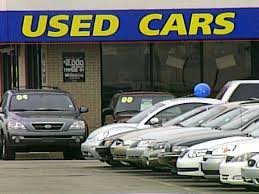Want to Sell a Vehicle? Attach a Video

At Dave Wright Nissan-Subaru in Cedar Rapids, Iowa, salespeople shoot and send a 55-second vehicle video to every prospect who calls, e-mails or walks into the showroom, dealer Dave Wright says.
The video requirement is helping the dealership sell more cars and has nudged salespeople to become more responsive, Wright says.
Industry statistics support him. Search engine giant Google, which owns YouTube.com, says more than half of all car shoppers watch at least a half-hour of video during the buying process. One in four watches an hour or more, Google says.
Likewise, recent data from AutoTrader.com show that shoppers are 20 percent more likely to click on a specific vehicle listing if it has video.
Anderson Automotive Group in Raleigh, N.C., is differentiating its eight stores by attaching videos to every vehicle listing on its Web sites and on third-party shopping sites, including Cars.com and AutoTrader.com.
The featured video over the past several weeks is a 30-second spot that tells viewers about the group's free Family Pack, says Andy Little, the group's director of variable operations. The pack is promoted as a $3,000 value that includes lifetime warranties on engines and transmissions of new vehicles and lifetime oil changes.
"We know videos work because people call us back and tell us how excited they are about the video we sent them," Wright says.
The sights and sounds in videos elicit emotional responses that text or still photos can't match, says Danielle Russell, Google's industry director for automotive, who is based in Detroit.
Google, with the help of research companies, surveyed more than 2,000 new-car buyers and charted the online shopping paths of 4,000 people.
The viewers looked at videos on numerous sites, including automakers' Web sites, dealer Web sites and YouTube, Russell says.
Punchy mandate
The sweet spot for video length in auto pitches is 30 seconds to two minutes, says Mike Rother, vice president of AutoTrader Group's HomeNet division, which helps dealers post inventory online.
Dealer Wright says salespeople are trained to keep their videos to 50 to 55 seconds. That length, he says, is adequate to show a vehicle and tell a story, while minimizing the risks that it will get snagged by an e-mail spam blocker or other computer firewall.
Wright, 47, says he mandated video response to all leads a little more than a year ago. For the first six months, results were choppy.
Salespeople felt they looked stilted in the videos, which required at least one scene with them in the frame as they circled or entered the vehicle they were promoting.
But Wright kept the faith. He bought four tablets for them to use and coached them to be natural in the videos and tell three things about the car that the customer might not know.
Before long, those who mastered videos were selling more vehicles, he says. That encouraged them and the others to invest in their own smartphones for videos and to download apps that assisted with some minor editing.
"We do videos on anything you can think of," Wright says.
Most of his dealership's videos are typical vehicle walk-arounds with narration from the salesperson. But some salespeople are getting edgy, too.
One customer, for example, drove her Subaru Legacy sedan to the store immediately after being broadsided at an intersection with her young child in a safety seat in the back seat.
An intrepid salesman grabbed his phone and filmed a short video of the car and its passengers, talking the whole time about the car's safety features, crumple zone and on the post-crash well-being of the mom and baby.
Videos are contributing to sales, Wright says. With the help of videos, his Nissan and Subaru franchises combined are selling about 117 new and used vehicles per month today, compared with about 90 a year ago, he says. The Nissan franchise just had a record November.
Little says the Anderson group stores have video for all of the 1,200 to 1,500 vehicles per month it posts on the stores' sites, AutoTrader.com and other sites. Leading the in-house video effort is Larry Pickett, the group's e-marketing director and former local TV producer and reporter.
Little says the Anderson group shoots most of its own video, often near a lake on the back part of the property of Fred Anderson Toyota in Raleigh. The company also uses Car-Mercial, a Boca Raton, Fla., automotive video technology company, to turn still photos into a slide show that resembles video, he says.
Like Dave Wright Nissan-Subaru, the Anderson group tries to mix in off-beat videos with the typical car walk-arounds with canned music and narratives.
Currently running is a video for Fred Anderson Toyota that is a takeoff on the reality show "The Bachelor." It shows a woman walking in the country pondering which of two suitors to choose as her next ride, a Toyota Prius or Toyota Corolla. It runs about three minutes.
Videos help boost store rankings on Google, Little says. Videos placed on YouTube can help push Anderson stores and their products to the crucial first page of a Google search when shoppers go looking for dealerships or vehicles, he says.
Shoot and score
Many dealers still rely on vendors to shoot car videos. But advances in inexpensive cameras and editing equipment are coaxing a growing number of dealership to shoot their own, says Rother of AutoTrader's HomeNet.
Hiring vendors to shoot videos for all cars in inventory can cost from $200 to more than $800 per month, he says.
HomeNet Automotive uses Flick Fusion Technologies, an Urbandale, Iowa video company, to produce videos for its dealer customers, Rother says.
Anderson group, which lists its inventory on AutoTrader, Cars.com and Edmunds.com, sought a way to stand out against rivals, and thinks it has found one.
Says Little: "Video is the way to engage people and get them to know a little more about us."
Related News


